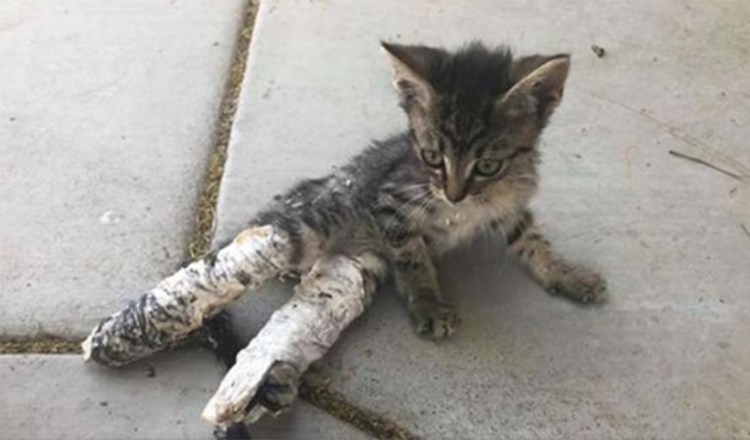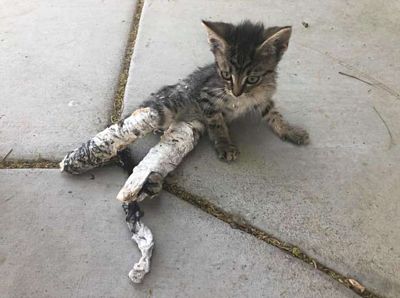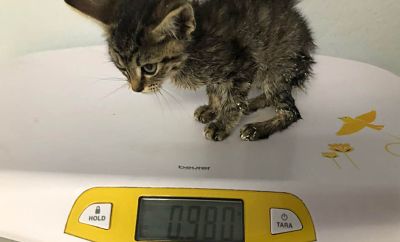A group of children were playing outside their apartments in arizona when they came across a tiny kitten. Initially, they may have wanted to play with it, but soon it was clear she was in no state to play, writes kittencatpost.
They did the right thing and brought the tiny bundle straight to their parents who called Kathy Hamel, director of Arizona Shih Tzu and Small Breed Rescue.

Her rear legs, apparently broken earlier, had been wrapped in some sought of crude casts? As soon as Kathy arrived she knew this little kitten had to be taken to her vet for evaluation of those legs.

One of the little kids who had brought the kitten to their parents came along with Kathy. She was probably 3 or 4 years old, she had named the kitten Cupcake and Kathy promised her she would keep the name.
It’s so good to see these kids were kind to Cupcake and helped her, some kids can be cruel like these kids were to this kitten.
Once they arrived at the vet’s they found the casts had to be soaked in water so they could be removed.

The veterinarian removed Cupcake’s cast and the worst was expected, after all, they were only covered in wooden splints and pieces of fabric. One of the casts was wrapped so tightly around the kitten’s tiny leg it had to soak a little longer.
Though neither the vet nor Kathy had ever seen anything like it. the rudimentary casts had done the job.

Kathy said, “besides the strange apparatus that she was dragging around behind her she was so incredibly tiny! She looked so much bigger in the picture I had been sent.” It’s unclear who put the casts on 6-week-old Cupcake and left her outside, but it took little time for her to warm up to her new human friends
“She is a tough little girl with a wonderful spirit,” Hamel said. “She has been so tolerant of all the pulling and washing and prodding and needles and thermometers and being handled by countless people, all who are only trying to help her. She purrs and craves attention and seems to hold no ill will towards humans for whatever they have done to her.”

She now has a foster family arranged and waiting to take her home
The kitten weighed only a pound then the casts were removed, and still needs to gain some weight before she can leave the shelter. Thankfully, Cupcake already has a foster family waiting to help her along as she recovers.

Cupcake is growing healthier every day.
“She pushes her head against your finger to make you rub on her and scratch her head,” Hamel said. “She loves to be petted but is so tiny you can only pet her with [a] finger or two and not a whole hand yet.”
This story originally appeared on kittencatpost.com
6 Most Common Cat Health Problems
Cats are good at self-maintenance. But even your fastidious feline can't prevent some of these more common cat diseases and health issues.
1. Vomiting
Vomiting is a very common problem with cats with a multitude of causes. They range from eating something poisonous or inedible (like string), to infection, urinary tract disease, or diabetes to hairballs.
Symptoms are usually obvious, and include drooling and abdominal heaving. Vomiting can quickly leave your cat dehydrated, so if kitty continues vomiting or acts ill, call your vet right away. It may help to collect a sample of your cat's vomit and take it with you to the vet.
2. Feline Lower Urinary Tract Diseases (FLUTD)
Some estimates say as many as 3% of cats seen by vets have feline lower urinary tract disease ( FLUTD), which is actually a group of feline diseases with multiple causes.
Female and male cats can get FLUTD, and it often occurs in cats that are overweight or unfit or who eat dry food. Stress, a multi-cat household, and sudden changes can all raise a cat's risk of FLUTD, and treatment depends on the type of FLUTD your cat has.
FLUTD symptoms include:
- Straining to urinate
- Bloody urine
- Urinating in unusual places
- Crying when urinating
- Licking around the urinary area (often because of pain)
- Depression
- Dehydration
- Lack of appetite
- Vomiting
It's always an emergency if your cat can't urinate. Call your vet immediately if you suspect your cat has a urinary tract problem.
3. Fleas
Fleas are a very common external feline health problem. But it's one you can easily treat. Signs your cat has fleas include:
- Flea dirt on its skin (they look like tiny black dots)
- Constant scratching
- Frequent licking
- Red or irritated skin
- Hair loss
- Skin infections or hot spots
Fleas can live for more than a year, and your cat risks anemia if the problem becomes serious, so be sure to treat your cat's flea problem and prevent future infestations.
Talk to your vet about which flea control would be best for your cat. Treatments include oral medication, powders, foams, and topical medication. Fleas are uncommon in Utah. If you adopt a pet from a region outside of Utah or are housing a pet that recently came from another state, please be aware of fleas.
4. Tapeworms
One of the most common feline health problems inside your cat, tapeworms live in kitty's small intestine and sometimes grow as long as 2 feet.
Symptoms of a tapeworm infection can be subtle but may include vomiting and weight loss. The easiest way to tell if your cat has tapeworms is to look at its feces and around its anus. If you see small white worms or what look like grains of rice or sesame seeds, your cat likely has tapeworms.
Treatment options include injection, oral, or topical medication. But because cats almost always get tapeworms as a result of swallowing a flea, be sure to handle any flea problems your cat has before tackling tapeworms.
5. Diarrhea
Many things can cause diarrhea in cats, including spoiled food, allergies, infection, liver disease, cancer, and more.
Symptoms of diarrhea are loose, watery, or liquid stool. Depending on its cause, diarrhea can last for a day, a week, or months.
If your cat has diarrhea, offer kitty plenty of fresh, clean water to prevent dehydration. Then remove kitty's food for no more than 12 to 24 hours. Take your cat to the vet if he or she still has diarrhea after a day or immediately if you notice vomiting, dark, or bloody stools, fever, lethargy, or loss of appetite or if your cat is straining to defecate.
6. Eye Problems
Eye problems in cats can be caused by a number of things, including conjunctivitis, cataracts, glaucoma, trauma, viruses, inflammation, and retinal disease.
A few symptoms that may mean your cat has eye problems include watery eyes, tear-stained fur, cloudiness, red or white eyelid linings, gunk in the corners of the eye, squinting, pawing at the eye, or a visible third eyelid.
Unless you know what's causing your cat's eye problems, there isn't much you can do other than wipe away any gunk with a damp cotton ball. After that, call your vet.




GIPHY App Key not set. Please check settings